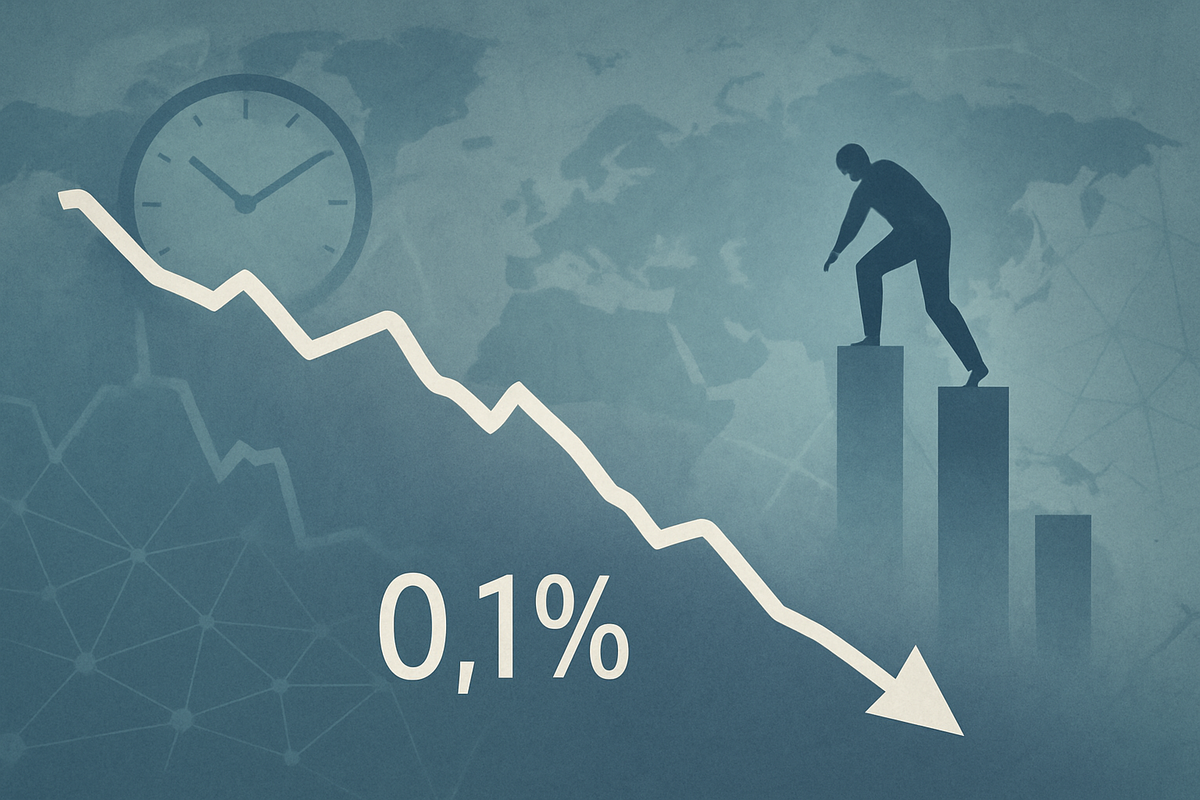
The U.S. economy is currently grappling with a significant deceleration in job growth, with proprietary data from investment giant Vanguard revealing a meager 0.1% growth rate for seven of the first nine months of 2025, dipping to an even more concerning 0.09% in September. This marks the slowest sustained pace of job creation since the tumultuous period of the 2009 Great Recession, casting a long shadow over the nation's economic outlook and raising urgent questions about its immediate and long-term implications.
This near-stagnant job growth signals a deeply fragile labor market, characterized by a "low hiring, low firing" environment where companies are largely hesitant to expand their workforces but are not yet engaging in widespread mass layoffs. The Federal Reserve is closely monitoring the situation, with officials like Governor Christopher J. Waller acknowledging the conflict between solid economic growth data and a softening labor market. This precarious balance could prompt the Fed to consider interest rate cuts to stimulate employment and avert a more severe economic downturn.
A Slowing Engine: Details of the 2025 Job Market Deceleration
The 0.1% job growth figure, while specifically highlighted by Vanguard's proprietary 401(k) data, is not an isolated anomaly. Official reports and analyses from various economic institutions corroborate a significant slowdown in the U.S. labor market throughout 2025. The U.S. Bureau of Labor Statistics (BLS) reported that total nonfarm payroll employment showed little change in August 2025, adding only 22,000 jobs, a stark contrast to previous years' averages. Furthermore, the BLS announced a substantial downward revision, indicating 911,000 fewer jobs were added through March 2025 than initially estimated, underscoring a weaker underlying market.
This deceleration has been attributed to a confluence of factors. Ongoing tariff uncertainty and evolving economic policies have made businesses wary of expansion, leading to slower hiring. Persistent inflation concerns and higher interest rates have also limited capital-intensive industries' growth. Additionally, a weakened immigration stance is impacting the labor supply, contributing to the dynamics of the job market. While mass layoffs haven't reached recessionary levels across all sectors, rising layoffs, particularly in the federal government, tech, and retail sectors, indicate growing caution among employers. The unemployment rate, while still historically low, has gradually climbed, reaching 4.3% in August 2025, with forecasts suggesting a potential rise to 4.5% by early 2026.
Winners and Losers in a Stagnant Job Market
A significant deceleration in U.S. job growth inevitably reshapes the corporate landscape, creating both opportunities and challenges for public companies. Sectors providing essential goods and services or offering cost-saving solutions tend to demonstrate greater resilience, while those reliant on discretionary spending or highly sensitive to economic cycles face considerable headwinds.
Potential Winners: Companies providing essential goods and services are often deemed recession-resistant. Healthcare providers like Abbott Laboratories (NYSE: ABT), which have historically outperformed broader markets during downturns, are expected to remain stable as healthcare needs are constant. Utilities, providing indispensable services like electricity and water, offer reliable dividends and may benefit from potential interest rate cuts. Consumer staples giants such as Procter & Gamble (NYSE: PG), PepsiCo (NASDAQ: PEP), General Mills (NYSE: GIS), Kroger (NYSE: KR), and Tyson Foods (NYSE: TSN) are well-positioned as consumers prioritize necessities over luxuries. Discount retailers like Walmart (NYSE: WMT), Dollar General (NYSE: DG), Dollar Tree (NASDAQ: DLTR), and Costco (NASDAQ: COST) thrive as consumers seek value. Even home improvement stores like Home Depot (NYSE: HD) can see increased activity as people opt to repair rather than replace. Select technology firms, especially those in cloud computing, cybersecurity, and essential software, may also win by offering solutions that help businesses cut costs and improve efficiency.
Potential Losers: Conversely, sectors dependent on robust consumer confidence and discretionary spending are vulnerable. Consumer discretionary businesses, including luxury goods, high-end retail, hospitality, and travel (airlines, hotels, restaurants), will likely see significant declines in demand. The automotive industry, with companies like General Motors (NYSE: GM) and Ford Motor Company (NYSE: F), is highly cyclical and sensitive to reduced consumer spending on big-ticket items. The broader real estate sector, particularly new construction, faces challenges from tighter credit and potentially higher borrowing costs. Manufacturing, especially of durable goods, will suffer from declining demand and disrupted global supply chains. Investment firms and insurers are exposed to declining stock prices and reduced financial activity. Furthermore, highly leveraged companies across all sectors will face increased financial distress, and companies significantly impacted by geopolitical factors and trade tensions, such as Tesla (NASDAQ: TSLA) and Nike (NYSE: NKE), could experience further market value losses.
Broader Significance: Echoes of the Past and Global Ripples
The current U.S. job growth deceleration, particularly its sustained pace at 0.1%, holds significant wider implications, drawing comparisons to historical economic challenges. While not yet a recession of the 2009 magnitude, it represents the slowest sustained pace of job creation since that period, signaling a fragile labor market and potential economic headwinds. During the Great Recession (2007-2009), the U.S. economy shed over 8 million jobs, and the unemployment rate soared to 10.0%. In contrast, 2025 is characterized more as a "cooling" or deceleration of a previously robust market, with the unemployment rate, while rising, still significantly lower than its 2009 peak. However, the current "low hire, low fire" environment suggests a cautious economic sentiment, reminiscent of periods preceding deeper downturns.
This U.S. slowdown has inevitable ripple effects on the global economy. As a major consumer and importer, reduced U.S. demand directly impacts export-oriented economies, particularly those in Asia and Latin America. This can lead to decreased global trade volumes, weakened global growth (already projected to slow to 2.3% in 2025), and increased financial market volatility. Emerging markets, already contending with higher borrowing costs, could face further strain from reduced capital inflows. Regulatory bodies and policymakers, especially the Federal Reserve, are under pressure to navigate this delicate balance, potentially implementing interest rate cuts to stimulate growth without reigniting inflation. The rise of AI tools, replicating tasks traditionally performed by new hires, also presents a novel structural challenge to employment across various industries globally, adding another layer of complexity to the current slowdown.
What Comes Next: Navigating an Uncertain Economic Horizon
The immediate future for the U.S. job market hinges on several critical factors. Short-term, the Federal Reserve's monetary policy response will be paramount. Anticipated interest rate cuts could provide some stimulus, but their effectiveness in reversing the deceleration remains to be seen. Companies will need to strategically pivot, focusing on efficiency, cost control, and potentially leveraging technology like AI to optimize operations rather than solely relying on workforce expansion. This environment creates both challenges and opportunities: while traditional growth sectors may struggle, businesses offering value, essential services, or innovative cost-saving solutions could find new avenues for expansion.
Long-term, the sustained low job growth rate raises concerns about the nation's economic trajectory and potential broader stagnation. Investors should closely monitor key economic indicators, including unemployment figures, consumer spending trends, and corporate earnings reports, particularly from companies sensitive to economic cycles. The potential for a prolonged period of subdued job creation could necessitate structural adaptations in labor policies, education, and industry investment. Scenarios range from a gradual recovery, bolstered by effective policy interventions, to a more protracted slowdown if underlying issues like trade tensions and weakened demand persist. The market will be watching for signs of either renewed hiring confidence or a further deterioration that could push the economy closer to a more significant downturn.
Wrap-Up: A Market at a Crossroads
The deceleration in U.S. job growth to a mere 0.1% in 2025 represents a critical juncture for the financial markets and the broader economy. While not yet mirroring the severity of the 2009 Great Recession in terms of outright job losses, the current pace of job creation is the slowest sustained rate since that period, signaling a fragile labor market and potential economic headwinds. The implications are far-reaching, from prompting potential Federal Reserve interest rate cuts to reshaping global trade dynamics and creating distinct winners and losers among public companies.
Moving forward, investors should remain vigilant, prioritizing companies with resilient business models, strong balance sheets, and those operating in essential sectors. The "low hire, low fire" environment suggests a cautious corporate approach, emphasizing efficiency over aggressive expansion. The next few months will be crucial in determining whether this deceleration is a temporary cooling-off or a precursor to a more significant economic challenge. Policymakers, businesses, and consumers alike will need to adapt to this evolving landscape, with a keen eye on how global economic forces, domestic policies, and technological advancements continue to shape the future of employment and economic growth.
This content is intended for informational purposes only and is not financial advice








